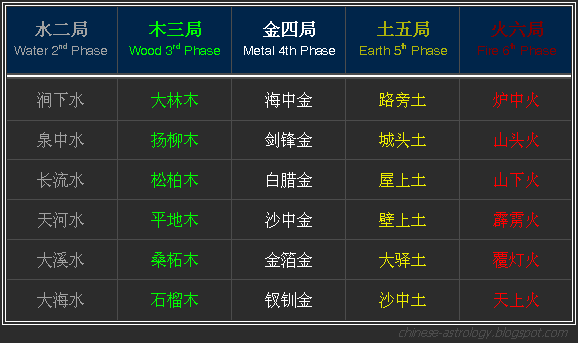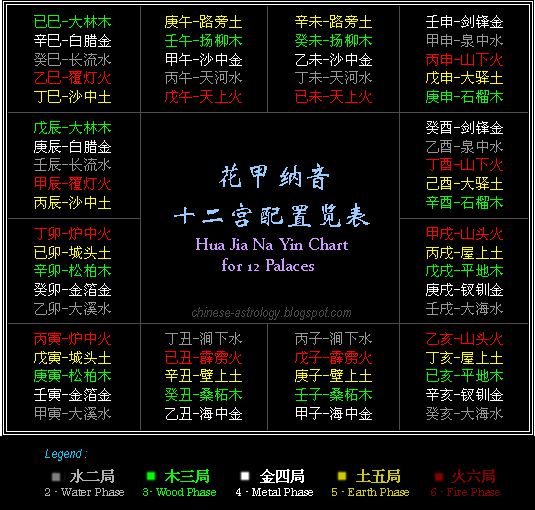and Time are derived from the Stems and Branches, one is borned with a specific Element.
In ZWDS, one's specific Element is termed “五行局 「 Wu Xíng Jú 」”. The purpose of 五行局
in ZWDS is to determine the placement of the Zi Wei Star (the first start to be charted),
and to establish the decade luck cycles. However some practitioners use it to assess the
overall chart and general picture of one's pre-determined destiny, or to put it in another
way, one's hidden qualities. How you are going to rectify your flaws or to maximise your
assets can be known from the stars readings.
五行局 「 Wu Xíng Jú 」 is based on the concept of the 花甲纳音 「 Huā Jia Nà Yīn 」. Strange as
it may sound, 花甲纳音 「 Huā Jia Nà Yīn 」 is a system derived from the 60-year cycle 六十花甲
「 Liù Shí Huā Jia 」 (which was covered in the earlier post) and *Musical notes 纳音 「 Nà Yīn 」.
五行局 consists of :
水二局 - Water 2nd Phase
木三局 - Wood 3rd Phase
金四局 - Metal 4th Phase
土五局 - Earth 5th Phase
火六局 - Fire 6th Phase
Notice the numbers start from 2 and ends with 6. The reason behind this has to do
with 八卦 「 Bā Guà 」 and 河图 「 Hé Tú 」, but I will not attempt to explain it now
because if I have to explain it from scratch, this would be a very very long post.
Nevertheless, bear in mind that the numbers here are important and will play a part later on.

And as mentioned earlier, 纳音 was infused into 五行局 and this produced a 纳音局 「 Nà Yīn Jú 」.

纳音局 「 Nà Yīn Jú 」 is a systematic breakdown of each Element into
6 different categories within itself. For example, the Wood Element 木三局 consists of :
大林木 - Forest trees
扬柳木 - Willow trees
松柏木 - Cypress trees
平地木 - Timber trees
桑柘木 - Chinese Mulberry trees
石榴木 - Pomegranate trees
From the meanings of the trees, it is not hard to guess the traits represented by each type of
wood. So as not to confuse readers, I will explain the meanings of each category in later posts.
The 30 categories (Na Yin) are then alloted to the 60-year combos (Hua Jia),
and this is the arrangement:

Or, you can view the original script on Hua Jia Na Yin here.

* Some background information on Chinese Musicology.
Music in ancient China was played on solo instruments or in small ensembles of plucked and bowed
stringed instruments, flutes, and various cymbals, gongs, and drums. The scale has only five notes :
角 「 jué 」 - the tone of Mi and represents Wood Element and Spring
征 「 zhi 」 - the tone of So and represents Fire Element and Summer
宫 「 gōng 」 - the tone of Do and represents Earth Element and change of season
商 「 shāng 」 - the tone of Re and represents Metal Element and Autumn
羽 「 yu 」 - the tone of La and represents Water Element and Winter
How the correlation between the 5 Elements and pentatonic scale came about is
profound and needs serious reading. However, according to surviving ancient texts,
all things correspond to the 5 Elements, hence correlations develop among all things.
For example, 司马迁 Sima Qian mentioned in his 史记 Shi Ji in Chapter: Music 《樂》,
“商 「 shāng 」 stimulates the lungs and harmonizes with Justice; 角 「 jué 」 stimulates the
liver and harmonizes with Kindness…”.


